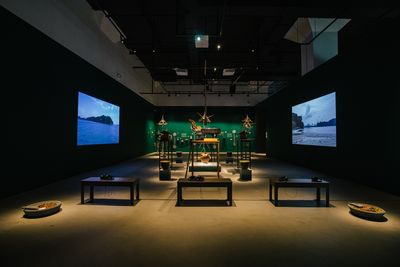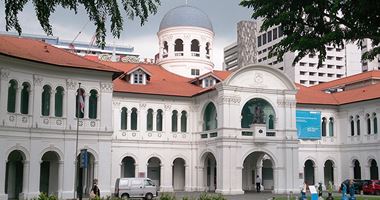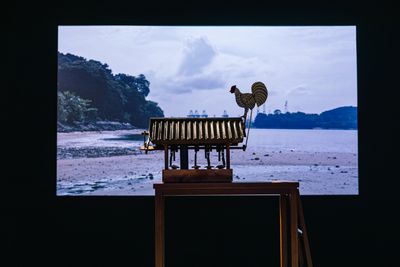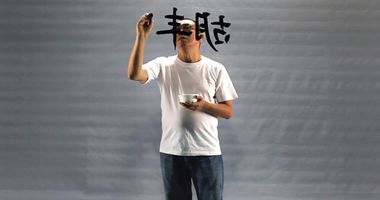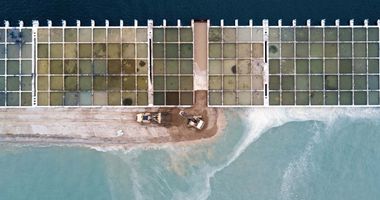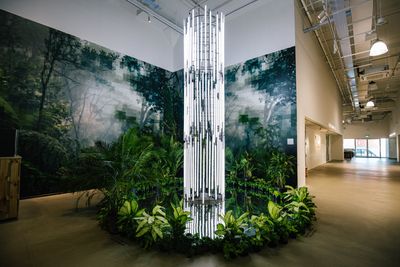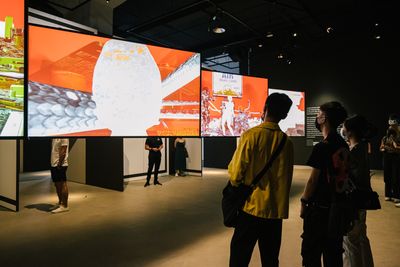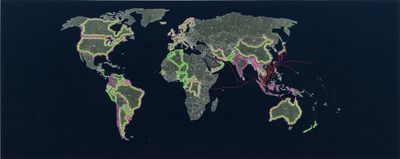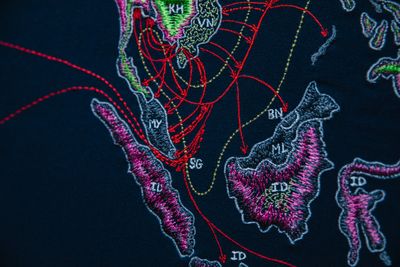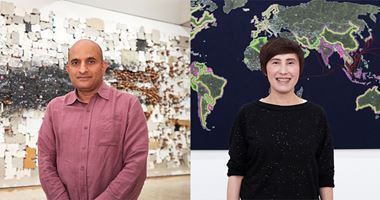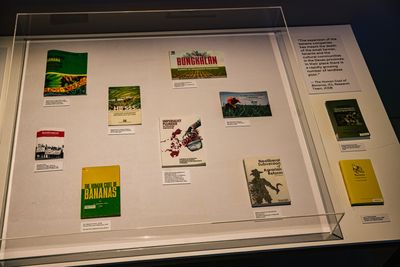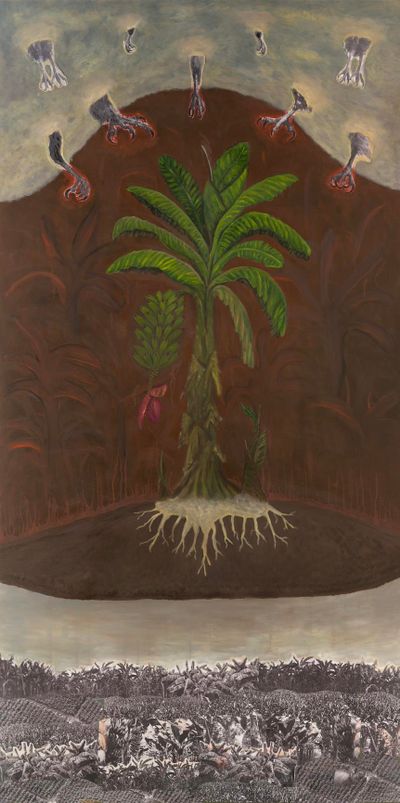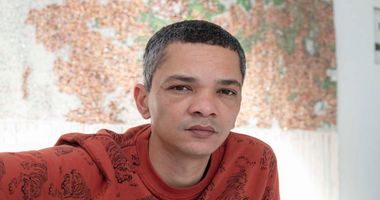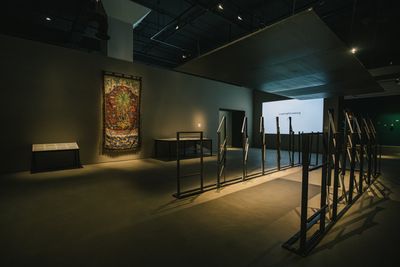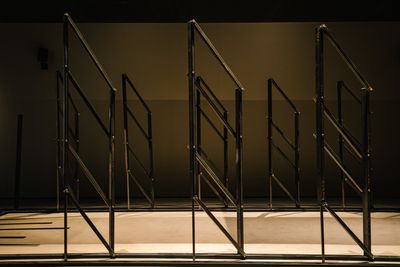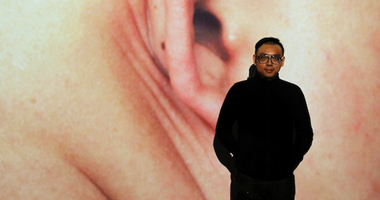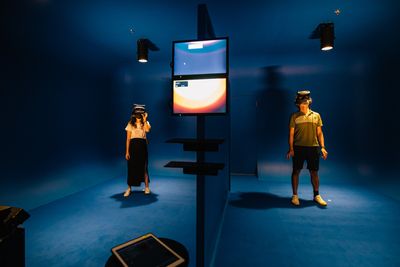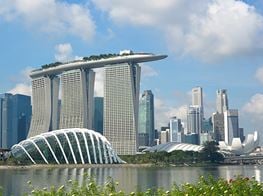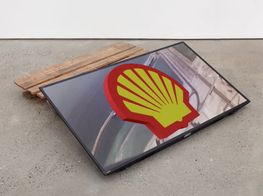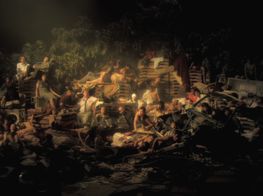At Singapore Art Museum, Artists Visualise the Intricate Flows of Globalisation
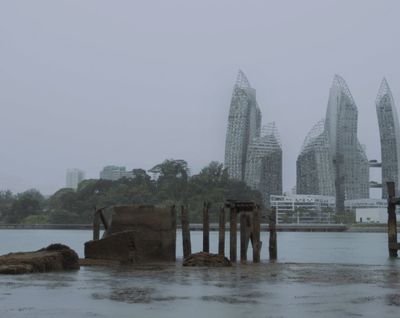
Zarina Muhammad, Zachary Chan, and Joel Tan, Dioramas for Tanjong Rimau (2022) (still). Multi-channel video installation, fermentation jar, wind instruments, spirit houses, salvaged oar, sand, and rock. Dimensions variable. Exhibition view: Lonely Vectors, Gallery 1, Singapore Art Museum, Tanjong Pagar Distripark, Singapore (3 June–4 September 2022). Courtesy SAM.
The constant sea breeze from the bustling Singapore Strait, one of global trade's most important shipping passages, sets in motion the mechanisms of an instrument installed in an obscure open-air walkway on the fifth floor of Tanjong Pagar Distripark (TPD).
A hybrid between a spirit house—a protective shrine commonly in the form of a small rooted structure—and a xylophone, the instrument produces melodic sounds as its wooden bars are struck, which counter the endless whirs and beeps of industrial machinery reverberating from the adjacent port.
Perched on a table, this spirit-house instrument faces wharves, shipping containers, and cargo cranes; it is a continuation of the polysensorial installation Dioramas for Tanjong Rimau (2022) by Zarina Muhammad, Joel Tan, and Zachary Chan.
Presented in the group exhibition Lonely Vectors at Singapore Art Museum (SAM) at TPD (3 June–4 September 2022), the rest of the work is installed in the main ground-level gallery of the museum, and revolves around a multi-channel video that poignantly and imaginatively delves into the palimpsestic relationships between the natural, urban, and spiritual landscapes of southern Singapore.
Accompanying the moving-image work is an amalgamation of materials arranged in a display, including four other spirit-house instruments, a fermentation jar, sand, rock, incense, photography, sound, and text.
Recalling ancient cosmologies and spirit paths, this multilayered arrangement examines topographies and terrains on the southern coast of Singapore scarred by urban infrastructure and development projects, alongside rituals of healing and remembering.
The sound-producing spirit house on the fifth floor conjures psychical and emotional connections to neighbouring land. Simultaneously, it puts into perspective the restlessness of maritime facilities and volumes of shipping traffic in southern Singapore's surrounding waters, which forms the nexus of the exhibition.
Since the 19th century, the area around Tanjong Pagar has been a thoroughfare for transformation and urbanisation due to growing economic activity around southern Singapore. In more recent history, the establishment of a terminal for container shipping—a development that revolutionised freight transport via reduced cost and increased efficiency—contributed to the city-state's meteoric growth in the 1980s.
Despite looming redevelopment plans of the area into a new complex on the western edge of the island, the logistics facility continues to handle the movements of goods and commodities.
Conceived in response to SAM's new space at TPD and its proximity to these historical and contemporary flows of trade and capital, Lonely Vectors brings together eight works ranging in scale, medium, and form, by nine Singaporean and international artists and one dance performance company, including Shu Lea Cheang, Ho Rui An, and Bo Wang.
Each artist is aligned in their exploration of the strategic movement of people, capital, and commodities alongside terrestrial, cosmic, and elemental flows of bodies ignited by a globalised world propelled by constant productivity and consumption.
Lending conceptual structure to the exhibition is the notion of the vector, described by curators Joella Kiu, Kenneth Tay, and Mi You in the exhibition's accompanying publication, as a representation of 'quantities that have both magnitude and direction, which may be added to, subtracted from and scaled'.
The scalability and elasticity associated with vectors prefigure the entanglements of issues discussed by the artworks in the exhibition, organised under three themes: 'Choreographies of Labour', 'More-than-Human Ecologies', and 'Heat Maps and Hot Zones'. But these themes do not translate to the show's spatial organisation, with numerous works housed in individual rooms and dispersed erratically across the venue; instead, they create further lines of thought to connect diverse perspectives.
As vectors are often represented as arrows, associations with mapping are palpable in two works, starting with Reconstructing an exodus history: boat trajectories, ports of first asylum and resettlement countries (2017) by Tiffany Chung, as part of Chung's larger 'The Vietnam Exodus Project' (2014–ongoing).
The latter uses interdisciplinary art and research methods to examine the damaging effects of the refugee crisis following the Vietnam War; one of the most significant forced global displacements of people in the second half of the 20th century.
Through a large, intricately hand-embroidered world map, Chung locates and traces departure points, routes, and ports of embarkation of Vietnamese political refugees who fled their homeland by boat between 1979 and 1989, making legible the traumatic movement of people in a compelling manner.
Also rooted in cartographic methods is Cian Dayrit's installation Penitent Plant (2022), which zeroes in on the Philippines' role as the third-largest exporter of Cavendish bananas globally. Conceived through counter-cartographic strategies, a central fabric work created with embroidery and digital print hangs on the wall.
Inspecting the global demand and supply of bananas while highlighting the human labour that fuels and bolsters its industry, the textile presents a banana tree in the middle. The tree is surrounded by references to organisations and industry players, such as Del Monte, Sumifru, and Dole. A lower section of the piece presents a digitally printed composite image of a banana plantation.
Embroidered over the image are tumbling human forms, burning flames, and texts that read, 'DOWN WITH FEUDALISM', 'LAND TO THE TILLERS', and 'RISE UP FOR FOOD SOVEREIGNTY AND CLIMATE JUSTICE', evoking the experiences, grievances, and predicaments of plantation workers.
Through its composition, Dayrit's textile illustrates the hierarchies of entangled forces that control the usage of land, labour, and food. Spotlighting his research and conceptualisation processes, a table to the fabric's left displays a series of hand-drawn mental maps by plantation workers.
A result of counter-cartography workshops with these marginalised communities organised by the artist, these map-like representations chart the geographies of landscapes the workers toiled in, their daily routines, demands, and sentiments.
Labour-related issues also come to the fore in Loading/Unloading (2022) by dance performance company P7:1SMA, situated in close proximity to Penitent Plant. Developed around extensive conversations with port workers around Tanjong Pagar, the installation encompasses numerous undulating structures reminiscent of scaffolding made from steel and metal.
Installed in a U-shaped formation in the middle of the gallery, these metal forms are shown alongside a single-channel video that documents the collective's rehearsals and site-specific performances in Tanjong Pagar, scheduled throughout the three-month-long exhibition.
In their laborious hour-long activations, performers dismantle and re-assemble the steel modules, and precariously manoeuvre across them, balancing and stepping on the modified structures, which resemble rocking vessels or seesaws.
In deliberately extending these performances beyond the gallery space to other sites within the industrial estate, performing bodies highlight the physically demanding and dangerous forms of labour that prop up these infrastructures and industries.
Beyond the human, Ho Tzu Nyen's virtual-reality installation H for Humidity (2022–ongoing) endeavours to re-frame and re-imagine Southeast Asia as a world of water and air by taking participants on a ten-minute journey to embody different states in the hydrologic system: evaporation, condensation, and precipitation.
Beginning their journey in solid form, viewers dissolve into liquid upon falling into a canal and are upswept by the current, into the open sea. Responding to the sun's warmth, the water evaporates into a gaseous state, gets sucked into an air-conditioning vent, condenses, and falls back to the ground as precipitated droplets.
H for Humidity is housed in a room impressively coloured in blue from floor to ceiling, with curved wall edges further emphasising the formlessness and fluidity of water. The installation's inclusion of an exit corridor referencing the water infrastructures of Singapore is a reminder of how this vital resource is controlled and managed, often to the detriment of the environment.
Across Lonely Vectors, compelling encounters like these—which are cerebral and require patient observation and attendance—set complex situations and issues of the contemporary world in relation.
Through different focal points, perspectives, and experiences, what arises is a feeling of urgency—of turning to new ways of living and thinking together. —[O]


